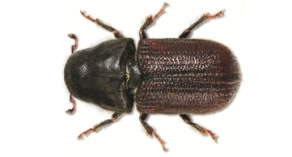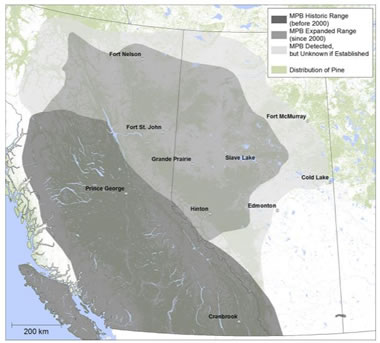Mountain pine beetle
The mountain pine beetle (Dendroctonus ponderosae) is a wood-boring insect native to western North America and attacks a wide range of pine trees including lodgepole, ponderosa, western white, whitebark, limber and jack. It does not attack Jeffrey pine.
The mountain pine beetle (MPB) has many natural predators including insects, parasitoids and woodpeckers. However, these enemies do not have sufficient impact to effectively control new or outbreak populations.
Quick facts
- An ongoing outbreak of mountain pine beetle that started in British Columbia in the early 1990s has affected more than 18 million hectares of forest
- The beetle has migrated well beyond its historic range into northern British Columbia and eastward into the boreal forest of north-central Alberta
- When a beetle population is low, healthy trees are able to defend and suppress an attack by producing a toxic resin. As more beetles come to a healthy tree, its natural defenses are overwhelmed
- Epidemic population levels decline only when all large pine trees are weakened or dead
- Beetle populations grow when summers are warm/dry and winters are mild

Mountain pine beetle (adult).
Larger image [246 kb JPG]
Impacts
- Since the early 1990s, the beetle has attacked 50% of the total volume of commercial lodgepole pine in British Columbia
- By 2017, the total cumulative loss of pine that could have been sold was estimated at 752 million cubic metres (58% of sellable pine volume)
- Efforts to control MPB outbreaks have been successful in reducing populations and slowing spread
- As the beetle spreads into new areas of the boreal forest, there are many new questions such as how quickly do populations spread and what impacts on forest ecology, as well as economic and social values will occur
MPB Biology
- The beetle has a one-year lifespan in most of its range. Lifespan may be shorter or longer depending on local temperatures
- Adult beetles colonize new host trees in July or August
- Female beetles release chemicals called aggregation pheromones, which communicate with other beetles to go to that tree
- Female beetles eat tunnels (“galleries”) into the inner bark of the tree to lay eggs
- Newly hatched larvae eat further into the tree
- Larvae usually spend the winter in the tree and complete their development the following spring; pupating in June or July
CFS scientific research
Scientists working at the Canadian Forest Service (CFS) have identified several factors that can determine the extent of the spread of the MPB.

The historic range (before 2000) and expanded range (after 2000) of MPB in Canada.
Larger image [59 kb JPG]
- Adult beetles fly to new trees and colonize as a normal feature of their life history
- The possibility of long-distance dispersal (greater than 100 km) under favourable weather conditions is well documented
- Milder winters and warmer summers contribute to population growth and survival rates.
- Pine stands in the boreal forest are typically less dense and have smaller trees than British Columbia’s lodgepole pine forests
- Evidence suggests that pine stand characteristics may not delay the spread and establishment of the beetle in boreal pine stands
Working collaboratively to develop solutions
The governments of provinces and territories affected are leading their own detection and control programs. These efforts include detecting the mountain pine beetle in new areas, removing and burning infested trees and harvesting affected stands before the economic value of the wood is lost or diminished.
Information gathered through current Canadian Forest Service research projects is used in an ongoing risk analysis as part of the National Forest Pest Strategy, a collaboration of federal, provincial and territorial experts. This knowledge is assisting forest managers with assessing the threat to Canada’s forests and identifying effective mitigation and adaptation options.
Want more information on the mountain pine beetle?
Send questions or comments to CFS Questions with "mountain pine beetle" in the subject heading.
- State of Canada’s Forests Annual Report — Indicator: Forest Insects
- Risk assessment of the threat of mountain pine beetle to Canada’s boreal and eastern pine forests (2019)
- Predicting the risk of mountain pine beetle spread to eastern pine forests: considering uncertainty in uncertain times (2017)
- Evaluation of precommercial thinning of lodgepole pine from long-term research installations in Alberta (2017)
- Characteristics of forest legacies following two mountain pine beetle outbreaks in British Columbia, Canada (2015)
- More CFS publications on the mountain pine beetle
- Government of British Columbia — Mountain pine beetle in British Columbia
- Government of Alberta — Mountain pine beetle in Alberta
Map source
- Risk assessment of the threat of mountain pine beetle to Canada’s boreal and eastern pine forests. 2019. Canadian Council of Forest Ministers, Ottawa, Ontario.
Page details
- Date modified: